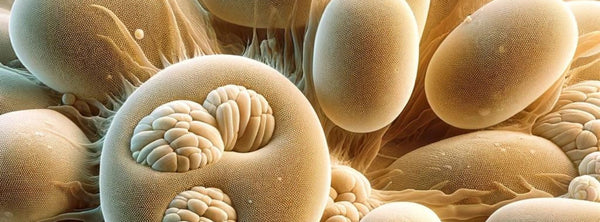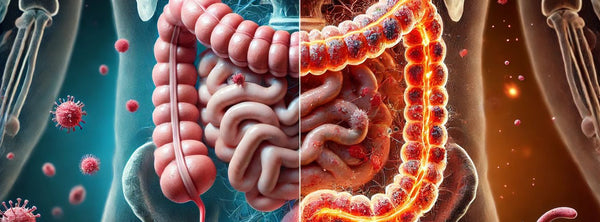
What is Pyroluria?
Pyroluria also is known as Pyrrole Disorder, Kryptopyrrole, Kryptopyrroluria, Mauve Factor and Hemepyrrole is considered by some a mental health condition, but in truth, it is the abnormal synthesis and metabolism of the haem carrying molecules.
A natural process for all cells is to eliminate waste and by-products. Haem containing cells, which include the oxygen-binding molecules haemoglobin and myoglobin, the antioxidant enzyme catalase and the detoxifying cytochromes all produce hydroxyhemopyrrolin-2-one (HPL) also known as pyrrole as their waste material. People who suffer from Pyroluria produce excessive amounts of HPL, which binds too, increases urine excretion or inhibits the function of Vitamin B6, Zinc and Biotin. [1] [2] Levels of the semi-essential fatty acid, GLA is also reduced. Unfortunately for Pyroluria sufferers HPL effectively renders zinc, B6 and biotin unavailable and supplementation is needed to reduce the severity of the Pyroluria symptoms and lower elevated HPL.
Zinc and vitamin B6 are essential cofactors in the manufacture of our antioxidant enzyme system, which includes glutathione, catalase and superoxide dismutase. HPL's ability to hamper the effectiveness of these nutrients decreases the ability of these antioxidant enzymes to protect against oxidative stress and free radical damage. [2] Oxidative stress causes an increase in cellular damage, impedes detoxification and contributes to mental illness, inflammatory conditions, heart disease, immune suppression and cancer. Antioxidants are substances found in foods and are produced by the body to protect our cells from damage. Vitamin C is a commonly known antioxidant and works by donating an electron to a free radical to render it harmless. One vitamin C molecule deactivates on free radical, but when the antioxidant enzyme system is activated, it wipes out millions of free radicals in one hit. For sufferers of Pyroluria antioxidants are an essential treatment strategy to help protect against the damaging effects of oxidative stress and elevated HPL.
Signs and Symptoms of Pyroluria
The roles of Zinc, Vitamin B6 and Biotin, are vast and complex with small deficiencies leading to a variety of symptoms, which vary from person to person. This is why a list of Pyroluria symptoms looks like an endless list of problems and why Pyroluria is looked upon as quackery by mainstream medicine and sceptical uninformed bloggers. Zinc, B6 and biotin are essential for all facets of health and are the cornerstones of a properly functioning brain, nervous, digestive and immune systems. Deficiencies not only effect Pyroluria sufferers but for all humans, both young and old. Below is a short list of some of the more common signs and symptoms associated with Pyroluria. [2]
| Anger – explosive | Lack of regular menstrual cycles |
| Anxiety/anxious | Low libido |
| Argumentative | Mood swings |
| Delayed puberty | Morning nausea |
| Delusions | Poor morning appetite |
| Depression | Prone to stitches |
| Dyslexia | Reading difficulties |
| Fatigue | Sensitivity to bright light, noise and smells |
| Emotionally unstable | Short term memory impairment |
| Frequent infections | Social withdrawal |
| Hyperactivity | Substance abuse |
| Intolerance to alcohol and drugs | Temper tantrums |
| Joint Pain | Poor dream recall |
For a full list of signs and symptoms associated with Pyroluria, please click here.
Conditions Associated with Pyroluria
In addition to the various signs and symptoms of Pyroluria, there are some health complaints and behavioural traits more commonly associated with the condition. The list below compares problems associated with Pyroluria and the percentage of those sufferers with elevated HPL levels. [2]
| Acute Intermittent Porphyria | 100% | Down Syndrome | 60% |
| ADD/ADHD | 47% | Epilepsy | 44% |
| Alcoholism | 20-84% | Learning Difficulties | 40-47% |
| Asperger’s Syndrome | 46-48% | Latent Acute Intermittent Porphyria | 70% |
| Autism spectrum disorders | 46-48% | Manic Depression | 47-50% |
| Bipolar Disorder | 46% | Neurosis/Neurotic | 20% |
| Criminal Behaviour | 71% | Schizophrenia | 59-80% |
| Depression | 46% |
Violent / Criminal Offenders |
33-71% |
For a full list of conditions associated with Pyroluria, please click here.
Read our blog on the 9 most Common Pyroluria Symptoms.
Unusual Body Appearances Associated with Pyroluria
For some Pyroluria sufferers, they can have abnormalities in their physical appearance. Some of the more common anomalies associated with Pyroluria are listed below. [2]
| Acne | Overcrowding of teeth |
| Early greying of hair | Poor wound healing |
| Hypo-pigmentation of skin | Skin appears paper-thin |
| Inability of the skin to tan | Stretch marks |
| Lack of hair on eyebrows or eyelashes | White spots on fingernails |
For a full list of body signs associated with Pyroluria, please click here.
What Causes Pyroluria?
Evidence suggests that for some sufferers, Pyroluria is a genetic condition. Statistics and research indicate that if a parent, grandparent, aunt, uncle, brother or sister suffer from Major Depression, Bi-Polar Disorder, Alcoholism, Schizophrenia or has Suicided, that there is a higher risk of Pyroluria in other family members.
Studies indicate that Lifestyle Factors can also play a role in driving up HPL levels, thus leading to Pyroluria.
- Research discovered that stress increases the production of HPL. [2]
- An unpublished US navy study conducted in 1992 found a very rapid increase in HPL levels in male volunteers who were subjected to the stress of a brief cold-water immersion. [2]
- Poor dietary choices and poor digestive health can lead to an increase in HPL levels. [2]
- Studies have shown that zinc deficiency increases bowel permeability leading to a condition known as Leaky Gut Syndrome. [3] [4] [5]. Leaky Gut Syndrome increases HPL in susceptible Pyroluria sufferers.
- It is a well-known fact that stress damages the intestinal wall and causes intestinal inflammation. Both of which lead to an increase in Leaky Gut Syndrome, Dysbiosis and worsening of Pyroluria Symptoms. [6], [7]
- Dysbiosis, an overgrowth of detrimental bacteria in the intestinal tract, has also been linked to an increase in blood HPL levels, which indicates Pyroluria. Dysbiosis is also a significant cause of Leaky Gut Syndrome. [2] [8]
- Stress increases the adherence of harmful bacteria to the intestinal wall within 30 minutes, which worsens Dysbiosis and in turn, drives up Pyroluria Symptoms [9]
- Alcohol, smoking, drugs and heavy metal exposure dramatically increase blood HPL levels. This is why sufferers of Pyroluria tend to get a worsening of their symptoms 24 to 48 hours after a big night on the town or recreational drug use.
- For more information on What Causes Pyroluria
Is Pyroluria Curable?
The simple answer for most is yes. Pyroluria can be disseminated into two types 'Genetic Pyroluria' and Lifestyle Generated Pyroluria'. For some, the genetic type is their underlying cause, but for most, Pyroluria is brought on by lifestyle choices. Stress, a diet rich in man-made processed foods, alcohol, drugs and chemical exposure coupled with leaky gut syndrome, poor liver detoxification, dysbiosis and poor digestion all combine to drive up HPL and worsen the symptoms of Pyroluria.
Regardless of the type of Pyroluria, it's of extreme importance to begin nutrient therapy to help reduce Pyroluria symptoms, improve deficiencies, lower oxidative stress and HPL or pyrrole levels. We recommend the Pyroluria Supplements Pyrrole Support Capsules and Antioxidant Support to help achieve this. Identifying underlying causes is the next important step. If this is confusing to do alone, there are many naturopaths trained in how to treat and heal these underlying conditions and poor lifestyle habits.
It is difficult to determine if a sufferers Pyroluria is Lifestyle Generated or the Genetic type. But, by supplementing and treating the underlying causes, both kinds of Pyroluria show significant improvements in symptoms. Subsequent testing shows reduce HPL levels in both types with the Lifestyle Generated generally coming back as negative, thus requiring no additional supplements or treatment.
|
|
NatroVital® Pyrrole Support offers a combination of essential vitamins and minerals, many of which are often deficient in sufferers of Pyroluria and Pyrrole Disorder. Pyroluria and Pyrrole Disorder are different names for the same condition. |
How is Pyroluria Diagnosed
A Pyroluria Test, previously known as a Kryptopyrrole Test, is a laboratory validated urine test, that can be done in the comfort of your own home. Pyroluria Testing is the only way someone can be 100% sure they have Pyroluria. For an accurate Pyroluria Test reading, there are a few simple but essential procedures that need to be completed. The urine sample needs to be collected in a semi-darken room as light degrades the sample. The sample is wrapped in foil, frozen overnight and sent the lab at the earliest convenience for testing. Most laboratories provide a courier pickup to transport the sample back to the lab usually on dry ice. Test results are either Positive, borderline or negative. Vitality and Wellness offers a Pyroluria Test with a treatment plan, lifestyle, dietary and nutritional recommendations based on your result.
Is Pyroluria Real?
Unfortunately, with many health conditions that are untreatable by mainstream medicine, they are deemed not real or don't exist. Regrettably, Pyroluria falls into this bracket, mainly because there are no drugs to increase Zinc, Vitamin B6 or Biotin or reduce oxidative stress; also, most doctors are not trained in nutrition. Along with this, there is misleading information available on the web, which is written by unqualified people who don't know, have treated or understand Pyroluria. Sadly, this combination leads people to believe that Pyroluria is a myth, and as such, allows them no effective treatment or proper diagnosis of Pyroluria.
What Damage Can HPL Do?
- Pyrroles (HPL) are classed as 'nerve poisons' and can damage nerves, nerve cells. [2]
- HPL decreases haem levels. Animal studies have shown that HPL caused a decrease in liver haem, and it's haem detoxifying enzyme cytochrome P450, by up to 55% over 48 hours. [10]
- Nerves metabolic activity is highly dependent on haem, low levels of haem lead to a metabolic crisis resulting in neuronal (nerve) cell death. [11] [12]
- Vitamin B6, Biotin and Zinc are all required for the production of haem and a reduction in these nutrients results in subnormal haem levels. [13] [14]
- Haem levels are further depressed by stress and heavy metal exposure. [2]
- Low levels of haem result in excess production of the toxic free radical nitric oxide, which can cause severe damage to brain tissue and is suspected of playing a role in schizophrenia, autism and Down Syndrome. [15] [16]
- Antioxidants protect cells from free radical damage. The body has 3 major antioxidant defence enzymes; Glutathione, Catalase and Superoxide Dismutase. All of these enzymes require Zinc or Vitamin B6 in some part in their production.
- A marginal deficiency of vitamin B6 is associated with lower levels of Glutathione production and cell mitochondrial (cell battery) decay. [17]
- Catalase consists of four protein subunits, each requiring hame. Autism and Schizophrenia sufferers have lower levels of catalase. [18] [19]
We hope you found this blog 'Understanding Pyroluria and What Causes It' of interest. If it was, please leave a comment or share on social media.
Thanks and have a great day!
REFERENCES - please click here.
The information provided in this blog 'Understanding Pyroluria and What Causes It' is of a general nature and intended for educational purposes only. We make no claims to diagnose, treat, prevent, alleviate or cure illnesses or diseases with any information or product stated. With any health issue, we suggest you consult your healthcare professional before undertaking any health treatment.







